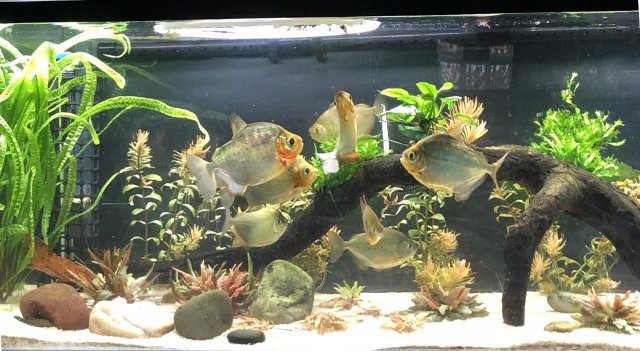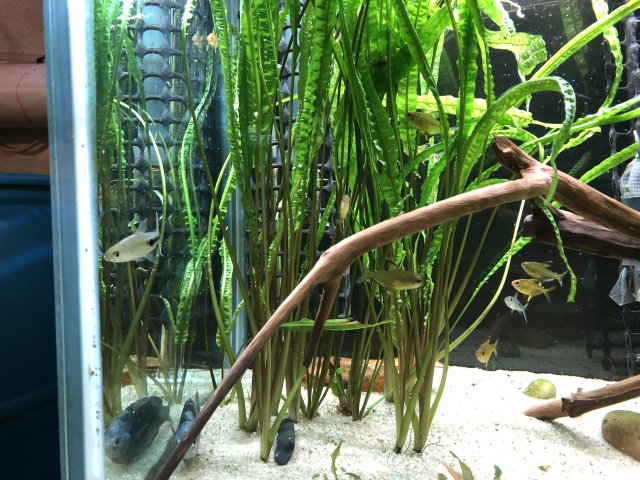Hemiodus anyone? Hemiodontidae (Show your fish)
- Thread starter FJB
- Start date
You are using an out of date browser. It may not display this or other websites correctly.
You should upgrade or use an alternative browser.
You should upgrade or use an alternative browser.
Thanks. They'll be adults soon enough, but I look forward to the day when they look like yours.
.
Your Prochilodus is beautiful. I enjoy the way you've incorporated vegetarians into planted aquariums. I would like to try this. It's nice to see the mixture of different size fish too. Beautiful and interesting aquarium!
.
I also keep some Red-tailed Hemiodus. I bought them about five years ago. I couldn't replace my last group of unimaculatus because I had not seen them for sale in many years.
.
In a book, "Baench Aquarium Atlas 2", scales are noted as differentiating the genus Hemiodus from Hemiodopsis. Of my fish, three have very fine scales and the others coarse, especially on the belly. So... possibly different genus as well.
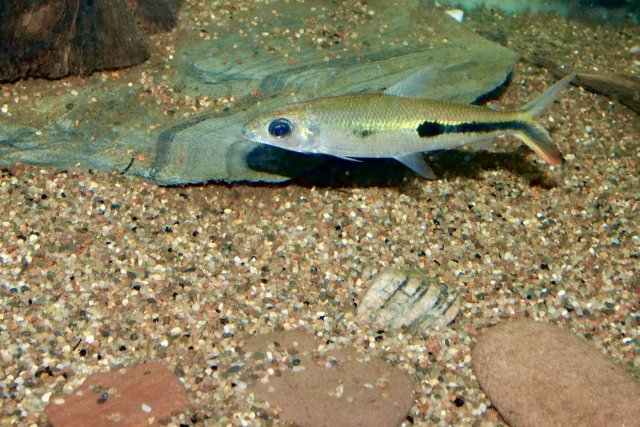
.
Your Prochilodus is beautiful. I enjoy the way you've incorporated vegetarians into planted aquariums. I would like to try this. It's nice to see the mixture of different size fish too. Beautiful and interesting aquarium!
.
I also keep some Red-tailed Hemiodus. I bought them about five years ago. I couldn't replace my last group of unimaculatus because I had not seen them for sale in many years.
.
In a book, "Baench Aquarium Atlas 2", scales are noted as differentiating the genus Hemiodus from Hemiodopsis. Of my fish, three have very fine scales and the others coarse, especially on the belly. So... possibly different genus as well.

Hey
C
Chet E.
, sorry I had not seen your last post. Thank you for showing your beautiful fish and sharing your experience with two different species of them.
Update on my fish - They and the whole tank are doing well, a lot of fun.
As you can see, it is a rather fast moving thank, even if some of the fish are slower. Feeding time is a frenzy. I have to feed attending to the various needs, but the Hemiodus cf argenteus are the absolute flashing eagerness in the flesh. And yet absolutely gentle with small and large fish alike. They are now 7-8 inches and close to 1 inch thick. The flagtail is 9-10".
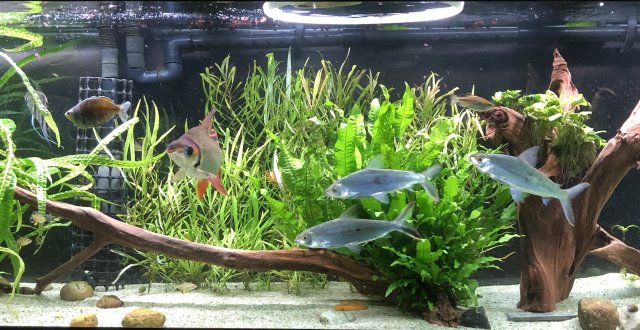
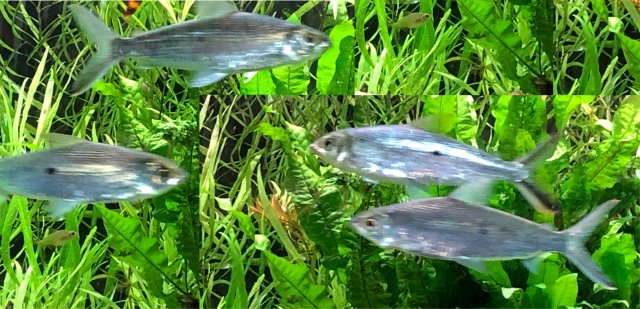
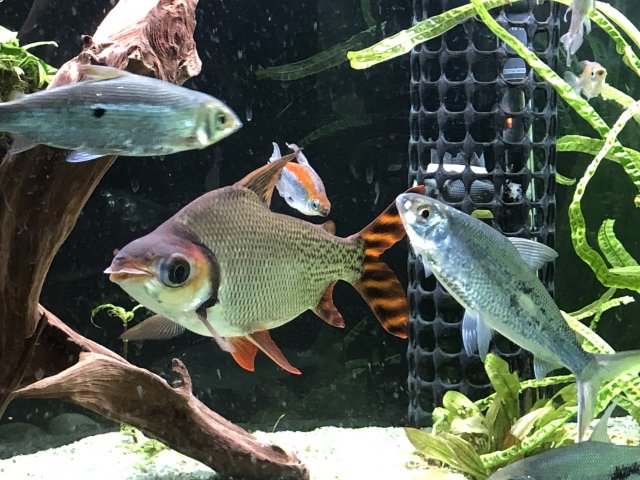
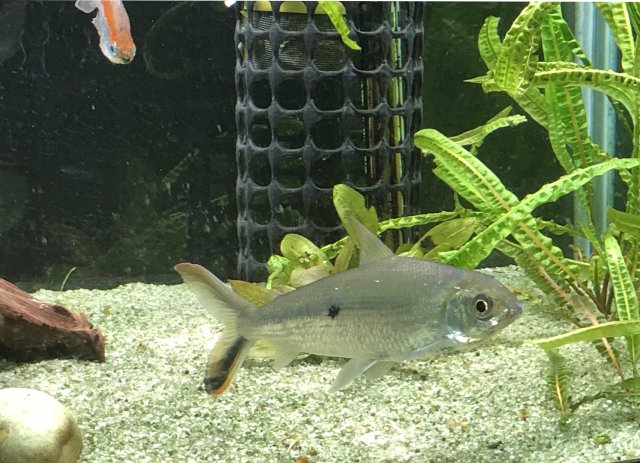
Cheers! Got any Hemiodus ???? Have pictures of any ???
Update on my fish - They and the whole tank are doing well, a lot of fun.
As you can see, it is a rather fast moving thank, even if some of the fish are slower. Feeding time is a frenzy. I have to feed attending to the various needs, but the Hemiodus cf argenteus are the absolute flashing eagerness in the flesh. And yet absolutely gentle with small and large fish alike. They are now 7-8 inches and close to 1 inch thick. The flagtail is 9-10".




Cheers! Got any Hemiodus ???? Have pictures of any ???
I've enjoyed your examples integrating herbivores and planted aquariums. I'd like to follow what you do. May I?
.
I maintain three species of cichlid, many different tetras and a few livebearers but my joy is with Doradid catfish and Hemiodid tetras. I have nine smaller aquariums but would like to move towards only three large primary aquariums with a four tank quarantine/fry system.
.
I see one of your plants has long crinkly leaves. Is it a Crinum natans?
.
I maintain three species of cichlid, many different tetras and a few livebearers but my joy is with Doradid catfish and Hemiodid tetras. I have nine smaller aquariums but would like to move towards only three large primary aquariums with a four tank quarantine/fry system.
.
I see one of your plants has long crinkly leaves. Is it a Crinum natans?
Update on my Hemiodus and new additions -
Fish continue to do very well continue to grow. Now they are at 7-8 inches and quite thick.
I continue to be uncertain of what species I have, but the 3 adults are definitely the same species :
- Some days I feel they are H. orthonops (supposed to have some black on both upper and lower lobes of the tail fin, but clear caudal peduncle), and a single black spot mid-body. Interestingly, the published drawings of H. unimaculatus are identical to those of H. orthonops, so it is a toss between those two taxa. However, only one of my 3 fish shows the black strongly on upper and lower caudal lobes; in the other 2 fish is quite faint in the upper lobe.
- Because of that (strong black on only lower caudal lobe), other days, I feel my adult fish are more like H. argenteus with single black spot midbody, and black on only the lower lower lobe of the tail fin.
To complicate things further, as they have grown all 3 fish are showing some red on the edge of the lower lobe of tail fin, strongest on the fish that has black on both lower and upper lobes. The red on the fin is much on less than on H. gracilis (the more common red-tail Hemiodus), which has more red and always has a strong black line from the mid-body spot and continuing to the end of the lower caudal lobe. In contrast a bit of red on lower caudal fish has not been described for orthonops, unimaculatus, or argenteus, but of course all are relatively poorly known, so variability (interspecific among individuals, or gender-related) is not well known.
Several weeks ago I found 4 very small specimens at a LFS in Pennsylvania. Of course I bought them at once! After deworming in quarantine, I have now added them to the tank with the others, and I show them here for the first time. Species-wise, these do not help, as they appear to be at least 2 species among the 4 new fish, and only one, the largest, looks the same as the adults in the tank. I guess some growing and further development (2 of them are tiny babies, barely larger than the lemon tetras!) will allow to better evaluate them.
- Some clear differences are:
The second largest of the 4 fish has a continuous black band extending from the mid-body black spot to the lower lobe of the caudal fin, and including the caudal peduncle. This is unlike both my 3 adult fish, and unlike at least 2 of the other small new fish. However, 2 of the small fish seem to have black bands that are intermediate in strength, and which may become stronger as the fish develop. None of the new ones have any red on the lower lobe of caudal fin (yet?).
I am excited about these new babies and the group of 7 Hemiodus, even if including more than one species. As expected from these very gentle yet active fish, the adults have not bothered the little ones at all! I hope as they grow they continue to be ok in this tank (a 125g), which is a bit on the smallish size for them. We will see. The adults have become very tame, even eating from my hand sometimes (they have learned from Prochilodus).
Photos - 1) The adults (more pictures earlier on this thread). 3 young ones visible n the background (two upper center, one bottom left). 2) Two of the new small ones.
Got any Hemiodus or have had them? Would you show them here, or tell of your experience with them?
Cheers!
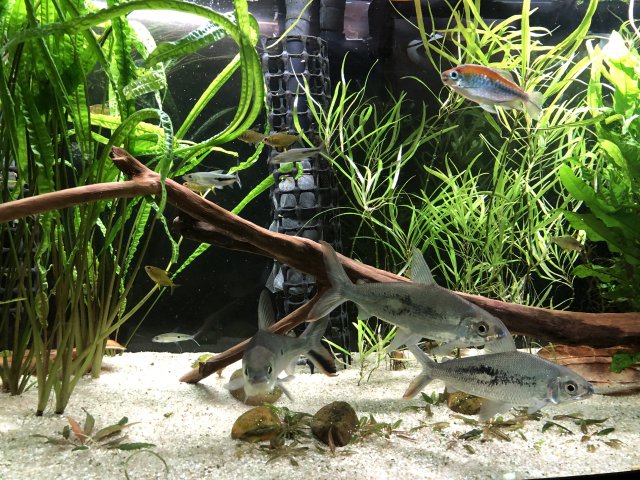
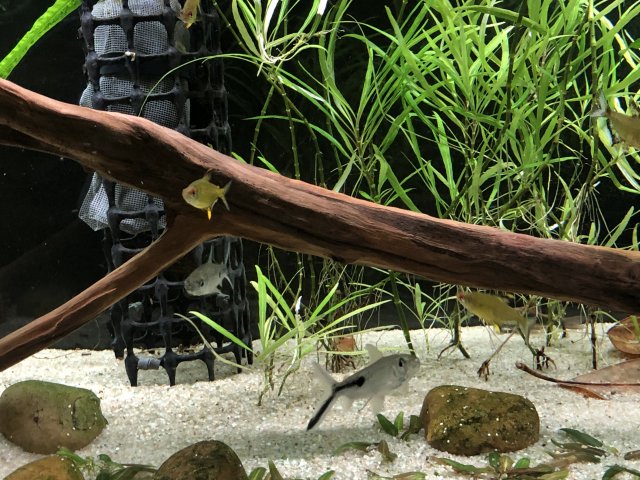
Fish continue to do very well continue to grow. Now they are at 7-8 inches and quite thick.
I continue to be uncertain of what species I have, but the 3 adults are definitely the same species :
- Some days I feel they are H. orthonops (supposed to have some black on both upper and lower lobes of the tail fin, but clear caudal peduncle), and a single black spot mid-body. Interestingly, the published drawings of H. unimaculatus are identical to those of H. orthonops, so it is a toss between those two taxa. However, only one of my 3 fish shows the black strongly on upper and lower caudal lobes; in the other 2 fish is quite faint in the upper lobe.
- Because of that (strong black on only lower caudal lobe), other days, I feel my adult fish are more like H. argenteus with single black spot midbody, and black on only the lower lower lobe of the tail fin.
To complicate things further, as they have grown all 3 fish are showing some red on the edge of the lower lobe of tail fin, strongest on the fish that has black on both lower and upper lobes. The red on the fin is much on less than on H. gracilis (the more common red-tail Hemiodus), which has more red and always has a strong black line from the mid-body spot and continuing to the end of the lower caudal lobe. In contrast a bit of red on lower caudal fish has not been described for orthonops, unimaculatus, or argenteus, but of course all are relatively poorly known, so variability (interspecific among individuals, or gender-related) is not well known.
Several weeks ago I found 4 very small specimens at a LFS in Pennsylvania. Of course I bought them at once! After deworming in quarantine, I have now added them to the tank with the others, and I show them here for the first time. Species-wise, these do not help, as they appear to be at least 2 species among the 4 new fish, and only one, the largest, looks the same as the adults in the tank. I guess some growing and further development (2 of them are tiny babies, barely larger than the lemon tetras!) will allow to better evaluate them.
- Some clear differences are:
The second largest of the 4 fish has a continuous black band extending from the mid-body black spot to the lower lobe of the caudal fin, and including the caudal peduncle. This is unlike both my 3 adult fish, and unlike at least 2 of the other small new fish. However, 2 of the small fish seem to have black bands that are intermediate in strength, and which may become stronger as the fish develop. None of the new ones have any red on the lower lobe of caudal fin (yet?).
I am excited about these new babies and the group of 7 Hemiodus, even if including more than one species. As expected from these very gentle yet active fish, the adults have not bothered the little ones at all! I hope as they grow they continue to be ok in this tank (a 125g), which is a bit on the smallish size for them. We will see. The adults have become very tame, even eating from my hand sometimes (they have learned from Prochilodus).
Photos - 1) The adults (more pictures earlier on this thread). 3 young ones visible n the background (two upper center, one bottom left). 2) Two of the new small ones.
Got any Hemiodus or have had them? Would you show them here, or tell of your experience with them?
Cheers!


Congratulations on your find. I look forward to seeing them grow out.
.
My ultimate dream species came up for sale at Wet Spot Tropical Fish, Argonectes longiceps. So, I've purchased eight and look forward to their arrival tomorrow. After quarantine they'll start out in a 55 gallon planted aquarium. But I'm looking forward to building them a larger home.
.
I hope there as the one I enjoyed long ago. A fish which hovered like a hummingbird and had the courage to dance with his biggest tankmates.
.
My ultimate dream species came up for sale at Wet Spot Tropical Fish, Argonectes longiceps. So, I've purchased eight and look forward to their arrival tomorrow. After quarantine they'll start out in a 55 gallon planted aquarium. But I'm looking forward to building them a larger home.
.
I hope there as the one I enjoyed long ago. A fish which hovered like a hummingbird and had the courage to dance with his biggest tankmates.
Hi Chet E. and All,
Thanks for responding. Congrats on your new Argonectes. I look forward to seeing them swimming in your tank sometime in the future. As well as more pictures of your Hemiodus and anything else you want to share.
I am posting here several photos of 2 individual fish (from the 4 new young ones I just got) (Each group of pictures shows the same fish in various views).
I believe 3 of those 4 fish are the same species among them (despite slight variation), and different than the adults. The last photos are the the 4th fish, which seems to be the same species as the adults; in fact, it schools with them, and tends to chase away the other 3, so their behavior seems to match their looks.
By the way, newer (molecular-based) data, including a new paper not quite out yet shows that Hemiodopsis is polyphyletic, and that the scale-size differences mentioned by Baench and others exist within Hemiodus groups, and 3 to 4 clades are newly recognized within Hemiodus (including former Hemiodopsis). Argonectes, Bivibranchia and other genera continue to be recognized as valid. Cheers!
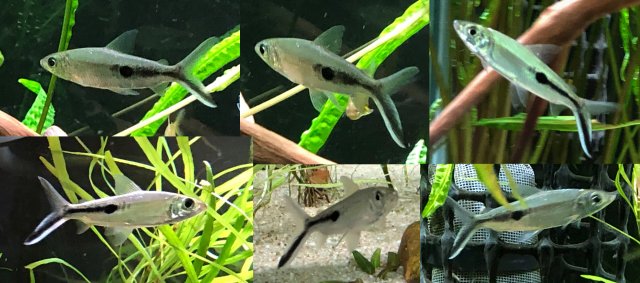
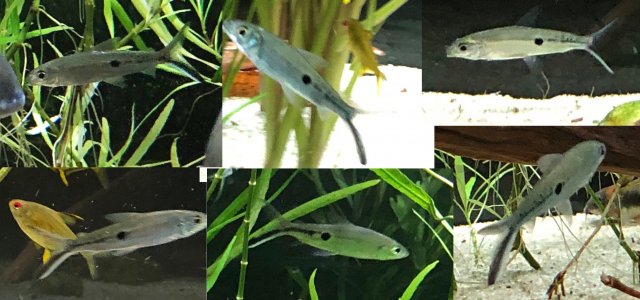
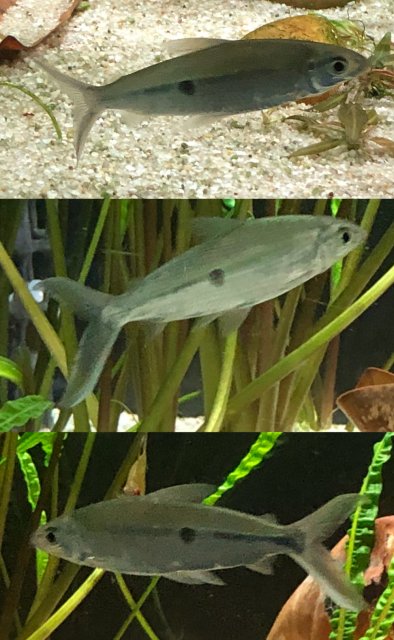
Thanks for responding. Congrats on your new Argonectes. I look forward to seeing them swimming in your tank sometime in the future. As well as more pictures of your Hemiodus and anything else you want to share.
I am posting here several photos of 2 individual fish (from the 4 new young ones I just got) (Each group of pictures shows the same fish in various views).
I believe 3 of those 4 fish are the same species among them (despite slight variation), and different than the adults. The last photos are the the 4th fish, which seems to be the same species as the adults; in fact, it schools with them, and tends to chase away the other 3, so their behavior seems to match their looks.
By the way, newer (molecular-based) data, including a new paper not quite out yet shows that Hemiodopsis is polyphyletic, and that the scale-size differences mentioned by Baench and others exist within Hemiodus groups, and 3 to 4 clades are newly recognized within Hemiodus (including former Hemiodopsis). Argonectes, Bivibranchia and other genera continue to be recognized as valid. Cheers!





